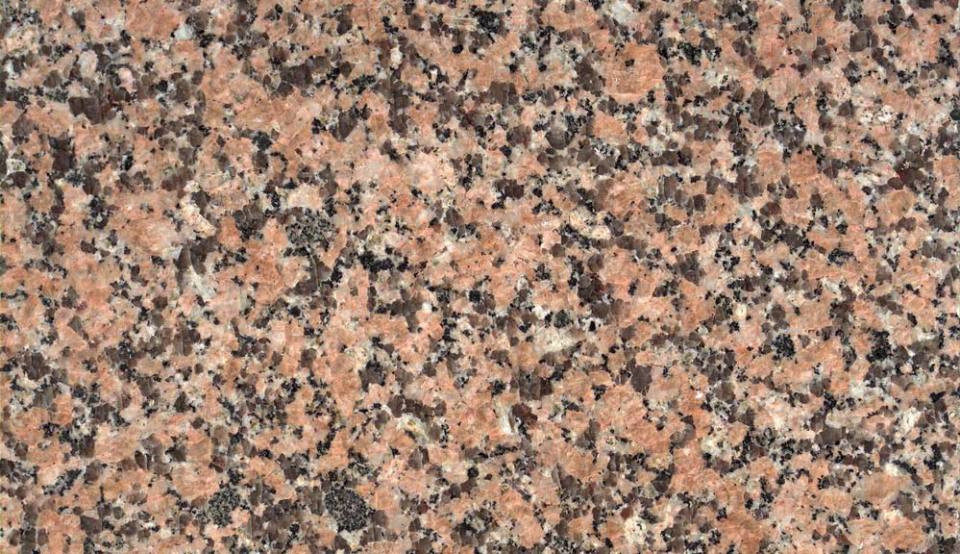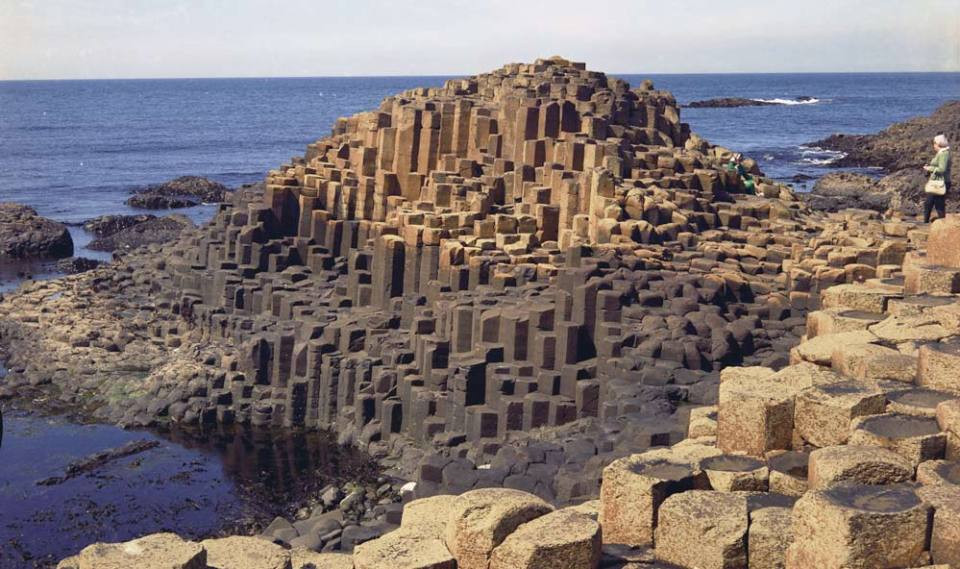Rocks are the foundation of our landscapes, and understanding their composition unlocks a deeper appreciation for the natural world; rockscapes.net can help you on your journey to creating the perfect landscape. Usually, multiple minerals combine to create a rock’s unique identity, impacting its appearance and properties; learn more about rock formations and mineral combinations!
1. What Exactly Is A Rock And How Is It Different From A Mineral?
A rock is generally composed of two or more minerals that are naturally combined through geological processes, whereas a mineral is a naturally occurring, inorganic solid with a defined chemical composition and crystalline structure. Think of minerals as the building blocks, and rocks as the structures built from those blocks.
- Minerals Defined: Minerals are like the pure ingredients. Each mineral has a specific chemical formula and a repeating atomic arrangement. For example, quartz (SiO2) always has one silicon atom for every two oxygen atoms, arranged in a specific crystal lattice.
- Rocks Defined: Rocks, on the other hand, are mixtures. They are aggregates of one or more minerals. A granite, for example, is commonly made up of quartz, feldspar, and mica.
- Formation Processes: Minerals form through various processes, including crystallization from magma, precipitation from solutions, and alteration of existing minerals. Rocks form through the consolidation of these minerals.
- Natural Occurrence: Both minerals and rocks are naturally occurring, meaning they are formed by geological processes without human intervention. This distinguishes them from synthetic materials.
2. How Many Minerals Typically Combine To Form A Rock?
The number of minerals that make up a rock can vary considerably, but most rocks are composed of two or more minerals. Some rocks, like quartzite, are composed almost entirely of a single mineral (in this case, quartz). Others, such as granite, can contain several different minerals in significant proportions.
-
Monomineralic Rocks: Rocks composed primarily of one mineral are called monomineralic. Examples include:
- Quartzite: Primarily composed of quartz.
- Limestone: Primarily composed of calcite.
- Rock Salt: Primarily composed of halite.
-
Polymineralic Rocks: Rocks composed of multiple minerals are called polymineralic. These are far more common and exhibit a wider range of properties and appearances. Examples include:
- Granite: Typically composed of quartz, feldspar (orthoclase, plagioclase), mica (biotite, muscovite), and sometimes amphibole.
- Gabbro: Typically composed of plagioclase feldspar and pyroxene.
- Sandstone: Composed of sand grains (often quartz) and may contain feldspar, mica, and rock fragments.
3. What Are The Most Common Minerals Found In Rocks?
The Earth’s crust is dominated by a relatively small number of rock-forming minerals. Feldspars are by far the most abundant, followed by quartz, pyroxenes, amphiboles, micas, and olivine. Other common minerals include calcite, dolomite, and clay minerals.
| Mineral | Chemical Formula | Occurrence |
|---|---|---|
| Feldspars | (Na,K,Ca,Ba)(Al,Si)4O8 | Most abundant mineral group; found in igneous, metamorphic, and sedimentary rocks. |
| Quartz | SiO2 | Common in igneous, metamorphic, and sedimentary rocks; very resistant to weathering. |
| Pyroxenes | (Mg,Fe,Ca)(Mg,Fe,Al)(Si,Al)2O6 | Common in mafic igneous rocks and some metamorphic rocks. |
| Amphiboles | A0-1B2C5T8O22(OH,F)2 (complex formula) | Common in igneous and metamorphic rocks; often found in hydrous environments. |
| Micas | X2Y4-6Z8O20(OH,F)4 (complex formula) | Common in metamorphic rocks; can also be found in igneous and sedimentary rocks. |
| Olivine | (Mg,Fe)2SiO4 | Common in mafic and ultramafic igneous rocks; relatively rare in other rock types. |
| Calcite | CaCO3 | Primary mineral in limestone and marble; also found in sedimentary rocks. |
| Dolomite | CaMg(CO3)2 | Found in dolostone; often forms through alteration of limestone. |
| Clay Minerals | (Al,Mg)2Si2O5(OH)4 (general formula) | Common in sedimentary rocks; formed by the weathering of other minerals. |
4. How Does The Mineral Composition Affect The Properties Of A Rock?
The mineral composition of a rock profoundly influences its physical and chemical properties. Hardness, color, density, cleavage, and resistance to weathering are all determined by the types and proportions of minerals present.
- Hardness: Minerals like quartz are very hard and make rocks more resistant to abrasion. Rocks high in softer minerals, like talc, are easily scratched. The Mohs Hardness Scale, which ranks minerals from 1 (talc) to 10 (diamond), helps in understanding a rock’s resistance to scratching.
- Color: The color of a rock is often a reflection of its mineral content. For example, iron-rich minerals can give rocks a reddish or brownish hue, while the presence of chlorite can result in a green color.
- Density: Minerals have different densities, and the overall density of a rock is an average of the densities of its constituent minerals. Rocks with heavy minerals like magnetite will be denser than rocks composed of lighter minerals like quartz.
- Cleavage and Fracture: Cleavage refers to the tendency of a mineral to break along specific planes of weakness in its crystal structure. Fracture describes irregular breakage. The way a rock breaks is influenced by the cleavage or fracture properties of its minerals.
- Weathering Resistance: Some minerals are more resistant to weathering than others. Quartz, for example, is very resistant to chemical weathering, while minerals like feldspar can alter to clay minerals over time.
5. What Are The Three Main Types Of Rocks And How Does Mineral Composition Differ Between Them?
The three main types of rocks are igneous, sedimentary, and metamorphic. Each type forms through different geological processes, and their mineral compositions reflect these distinct origins.
-
Igneous Rocks: Igneous rocks form from the cooling and solidification of magma or lava. Their mineral composition is largely determined by the chemistry of the parent magma and the rate at which it cools.
-
Intrusive (Plutonic) Igneous Rocks: These rocks cool slowly beneath the Earth’s surface, allowing large crystals to form. Examples include granite (quartz, feldspar, mica) and gabbro (plagioclase, pyroxene).
 Peterhead granite samplePeterhead granite from Scotland features pinkish feldspar, grey quartz, and black biotite mica, showcasing the mineral composition of intrusive rocks formed deep underground.
Peterhead granite samplePeterhead granite from Scotland features pinkish feldspar, grey quartz, and black biotite mica, showcasing the mineral composition of intrusive rocks formed deep underground. -
Extrusive (Volcanic) Igneous Rocks: These rocks cool quickly on the Earth’s surface, resulting in small crystals or a glassy texture. Examples include basalt (plagioclase, pyroxene) and rhyolite (quartz, feldspar).
 Giant
GiantThe Giant’s Causeway in Northern Ireland, made of extrusive basalt columns, exemplifies rapid lava cooling and joint formation, showcasing fine-grained rock.
-
-
Sedimentary Rocks: Sedimentary rocks form from the accumulation and cementation of sediments, such as mineral grains, rock fragments, and organic matter.
- Clastic Sedimentary Rocks: These rocks are composed of fragments of other rocks and minerals. Examples include sandstone (quartz, feldspar, rock fragments), shale (clay minerals, quartz), and conglomerate (rounded pebbles and cobbles).
- Chemical Sedimentary Rocks: These rocks form from the precipitation of minerals from solution. Examples include limestone (calcite), rock salt (halite), and chert (microcrystalline quartz).
- Organic Sedimentary Rocks: These rocks are composed of the remains of plants and animals. Examples include coal (carbon) and some types of limestone (shells and skeletal fragments).
-
Metamorphic Rocks: Metamorphic rocks form when existing rocks are transformed by heat, pressure, or chemically active fluids. The mineral composition of metamorphic rocks depends on the parent rock (protolith) and the conditions of metamorphism.
- Foliated Metamorphic Rocks: These rocks exhibit a layered or banded appearance due to the alignment of minerals under pressure. Examples include slate (clay minerals, mica), schist (mica, quartz, feldspar), and gneiss (quartz, feldspar, mica, amphibole).
- Non-Foliated Metamorphic Rocks: These rocks do not exhibit a layered appearance. Examples include marble (calcite or dolomite) and quartzite (quartz).
6. How Does The Grain Size Of Minerals In A Rock Affect Its Properties?
The grain size of minerals in a rock plays a significant role in determining its properties. Grain size affects the rock’s texture, appearance, porosity, and strength.
- Fine-Grained Rocks: Fine-grained rocks have small mineral crystals that are difficult to see with the naked eye. These rocks often have a smooth texture and low porosity. Examples include shale and basalt.
- Coarse-Grained Rocks: Coarse-grained rocks have large mineral crystals that are easily visible. These rocks often have a rough texture and higher porosity. Examples include granite and conglomerate.
- Porphyritic Rocks: Porphyritic rocks have a mixture of large and small crystals, indicating a two-stage cooling history. Large crystals (phenocrysts) formed slowly at depth, while the surrounding matrix (groundmass) cooled more quickly on the surface.
7. What Are Some Examples Of Rocks With Unusual Mineral Compositions?
While most rocks are composed of common minerals, some rocks have unusual or rare mineral compositions that make them particularly interesting or valuable.
- Kimberlite: Kimberlite is a rare type of igneous rock that is known for containing diamonds. Its mineral composition includes olivine, pyrope garnet, phlogopite mica, and ilmenite, in addition to diamond.
- Eclogite: Eclogite is a metamorphic rock that forms at very high pressures and temperatures. It is composed primarily of garnet and omphacite pyroxene, which are not commonly found in other rock types.
- Serpentinite: Serpentinite is a metamorphic rock that forms from the alteration of ultramafic rocks. It is composed primarily of serpentine minerals, such as antigorite, lizardite, and chrysotile.
8. How Can You Identify The Minerals In A Rock?
Identifying the minerals in a rock can be a challenging but rewarding process. Geologists use a variety of techniques to identify minerals, including visual inspection, hardness tests, streak tests, and chemical analysis.
- Visual Inspection: Start by examining the rock closely with a hand lens or microscope. Look for distinct mineral grains, colors, and textures.
- Hardness Test: Use a set of hardness picks or common objects (like a fingernail, copper penny, or steel nail) to test the hardness of the minerals. Compare your results to the Mohs Hardness Scale.
- Streak Test: Rub the mineral across a streak plate (a piece of unglazed porcelain) to determine the color of its streak. The streak color can be different from the color of the mineral itself.
- Acid Test: Place a drop of dilute hydrochloric acid on the rock. If it fizzes or bubbles, it likely contains carbonate minerals like calcite or dolomite.
- Chemical Analysis: For more precise identification, geologists use techniques like X-ray diffraction (XRD) and electron microprobe analysis to determine the chemical composition and crystal structure of the minerals.
9. How Does Mineral Composition Influence Rock Weathering And Erosion?
The mineral composition of a rock strongly influences its susceptibility to weathering and erosion. Rocks composed of resistant minerals like quartz tend to weather slowly, while rocks composed of less resistant minerals like feldspar weather more quickly.
- Chemical Weathering: Chemical weathering involves the alteration of minerals through chemical reactions with water, acids, and gases. Minerals like feldspar can undergo hydrolysis, where they react with water to form clay minerals.
- Physical Weathering: Physical weathering involves the breakdown of rocks into smaller pieces without changing their chemical composition. Freeze-thaw cycles, abrasion, and exfoliation can all contribute to physical weathering.
- Differential Weathering: Differential weathering occurs when different parts of a rock weather at different rates due to variations in mineral composition or exposure to weathering agents.
10. What Role Do Rocks And Their Mineral Composition Play In Landscaping?
Rocks play a crucial role in landscaping, providing both aesthetic appeal and functional benefits. The mineral composition of rocks influences their color, texture, and durability, making them suitable for a variety of landscaping applications.
- Aesthetic Appeal: Rocks add natural beauty and visual interest to landscapes. Different types of rocks can be used to create a variety of styles, from rustic and naturalistic to modern and minimalist. Explore the variety of landscape styles at rockscapes.net.
- Erosion Control: Rocks can be used to stabilize slopes, prevent soil erosion, and create terraces. Large boulders and retaining walls can help to hold back soil and create level planting areas.
- Drainage: Rocks can be used to improve drainage in gardens and planting beds. A layer of gravel or crushed stone can help to prevent waterlogging and promote healthy root growth.
- Pathways and Patios: Flat rocks like flagstone can be used to create pathways and patios. The mineral composition of the rocks influences their durability and resistance to weathering.
- Rock Gardens: Rock gardens showcase the beauty of rocks and plants in a naturalistic setting. Rocks of different sizes and shapes can be used to create a variety of microclimates and planting pockets.
Interested in using rocks to enhance your landscape? Contact us today! Address: 1151 S Forest Ave, Tempe, AZ 85281, United States. Phone: +1 (480) 965-9011. Website: rockscapes.net.
Rocks are more than just static objects; they’re dynamic records of Earth’s history, with each mineral grain telling a story of its formation and transformation. Understanding the mineral composition of rocks allows us to appreciate their unique properties and use them effectively in landscaping and other applications.
FAQ: Unveiling the Secrets of Rock Composition
Here are some frequently asked questions about the mineral composition of rocks:
1. Can a rock be made of just one mineral?
Yes, a rock can be monomineralic and consist primarily of one mineral. Examples include quartzite (composed mostly of quartz) and limestone (composed mostly of calcite).
2. What is the most abundant mineral in rocks?
Feldspar is the most abundant mineral in the Earth’s crust and is a major component of many rock types, including igneous, metamorphic, and sedimentary rocks.
3. How do geologists determine the minerals present in a rock?
Geologists use various methods, including visual inspection, hardness tests, streak tests, acid tests, and advanced techniques like X-ray diffraction and electron microprobe analysis.
4. Does the color of a rock indicate its mineral composition?
Yes, the color of a rock can often provide clues about its mineral composition. For example, iron-rich minerals can give rocks a reddish or brownish hue, while chlorite can result in a green color.
5. How does the cooling rate of magma affect the mineral composition of igneous rocks?
The cooling rate of magma affects the size of mineral crystals in igneous rocks. Slow cooling allows large crystals to form (intrusive rocks), while rapid cooling results in small crystals or a glassy texture (extrusive rocks).
6. What is the role of weathering in altering the mineral composition of rocks?
Weathering processes, both chemical and physical, can alter the mineral composition of rocks. Chemical weathering can cause minerals to break down and form new minerals, while physical weathering can break rocks into smaller pieces.
7. Are metamorphic rocks made of the same minerals as the original rocks they came from?
Not necessarily. Metamorphism can cause the original minerals in a rock to recrystallize and form new minerals that are stable under the new temperature and pressure conditions.
8. Can the mineral composition of rocks affect plant growth in landscaping?
Yes, the mineral composition of rocks can affect plant growth. Some minerals can release nutrients that are beneficial to plants, while others can be toxic or create unfavorable soil conditions.
9. What are some examples of rocks used in landscaping, and what minerals do they contain?
Common landscaping rocks include granite (quartz, feldspar, mica), sandstone (quartz, feldspar), limestone (calcite), and slate (clay minerals, mica). Each type offers unique aesthetic and functional properties.
10. Where can I find more information about different types of rocks and their mineral compositions for landscaping projects?
Visit rockscapes.net for detailed information, design ideas, and expert advice on selecting and using rocks to create beautiful and sustainable landscapes. Find inspiration and practical tips to bring your vision to life!
